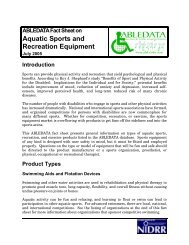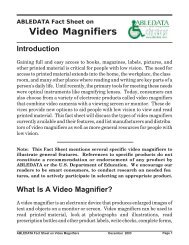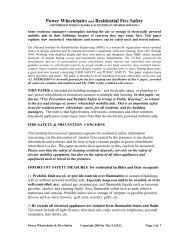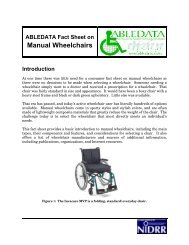Power Wheelchairs and User Safety - AbleData
Power Wheelchairs and User Safety - AbleData
Power Wheelchairs and User Safety - AbleData
You also want an ePaper? Increase the reach of your titles
YUMPU automatically turns print PDFs into web optimized ePapers that Google loves.
windshield <strong>and</strong> to their deaths because they did not follow these<br />
precautions. These must apply whether the van is privately owned, rented<br />
or a public for-hire service vehicle.<br />
12) Outdoor STAIR-CLIMBING <strong>Wheelchairs</strong>. Outdoor steps are usually<br />
wider, deeper <strong>and</strong> shallower than inside steps, <strong>and</strong> often of shorter height.<br />
Some outdoor power wheelchairs with large, powered wheels in front,<br />
are designed to safely carry the user up or down flights of outdoor steps,<br />
as found in front of courthouses or public buildings. These chairs cannot<br />
safely carry a person up or down the types of stairs found indoors, in<br />
homes, offices <strong>and</strong> public buildings. Never try on indoor stairways!<br />
13) Indoor STAIR-CLIMBING <strong>Wheelchairs</strong> are the most dangerous to use<br />
because indoor steps are steep, narrow, high <strong>and</strong> have short depths as<br />
compared with outdoor steps. Most indoor stairways are not designed to<br />
support heavy weight in one area <strong>and</strong> can crack or break without warning.<br />
Also, indoor steps often have poor visibility so that unseen clutter, wet<br />
spots <strong>and</strong> damaged areas can cause the heavy power wheelchair to slip,<br />
slide, lose its grip on the stairs, <strong>and</strong> crash to the bottom injuring or killing<br />
the user. CAUTION: Always have an able-bodied wheelchair technician<br />
or mobility trainer who is familiar with the stair-climber, test climb <strong>and</strong><br />
descend a particular flight of indoor stairs before the wheelchair user tries<br />
it. Even then, the wheelchair user should climb <strong>and</strong> then descend the same<br />
stairway two or three times in the presence of the technician or trainer.<br />
CAUTION: Stair-climbing wheelchairs may be unsafe in a private home<br />
because they are heavy. With batteries, such a wheelchair may weigh<br />
about 400 lbs. Add 200 lbs. for the user <strong>and</strong> the total weight can equal 600<br />
lbs. This is enough weight to crack, break or dislodge one or more steps,<br />
causing the wheelchair <strong>and</strong> user to fall down the entire flight of stairs.<br />
14) Periodic Preventive MAINTENANCE is absolutely necessary to<br />
maintain the safety of any power wheelchair, stair-climbing or not. We<br />
recommend daily minor, <strong>and</strong> weekly major inspections by the user. We<br />
also recommend a professional inspection at least once every 3 months for<br />
most users, <strong>and</strong> as often as once a month for very active <strong>and</strong>/or severely<br />
disabled users. If tires are air-inflated, air pressure should be checked<br />
before each day’s use. Solid tires should be visually inspected for breaks.<br />
For SAFETY, legal <strong>and</strong> financial reasons, it is recommended that all<br />
power wheelchair service be provided by the seller, by the manufacturer<br />
or by a local mechanic who is designated as a “manufacturer’s<br />
representative”.<br />
<strong>Power</strong> <strong>Wheelchairs</strong> & <strong>User</strong> <strong>Safety</strong> Copyright 2003 by The N.I.R.E. Page 7 of 8







